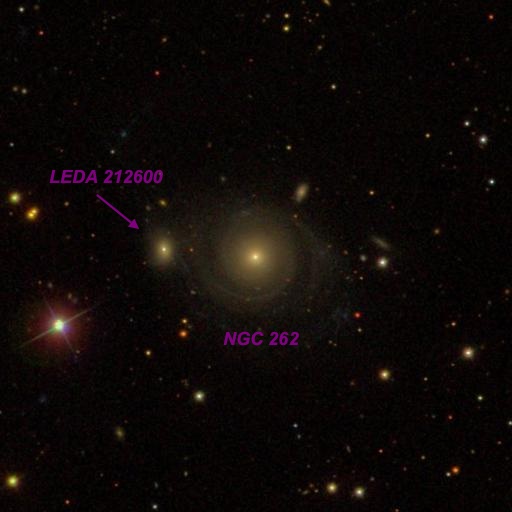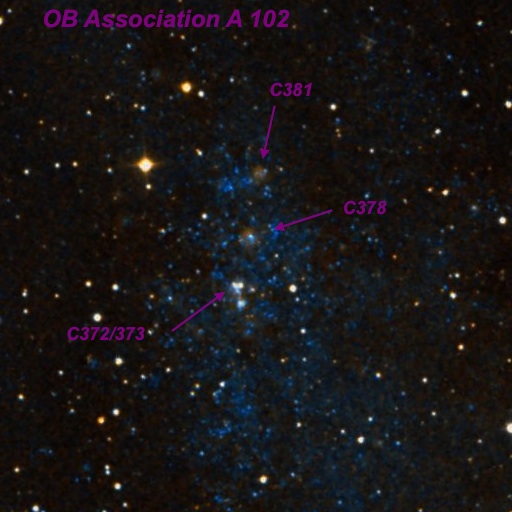OR 11/24/14: Lake Sonoma
by Steve Gottlieb
|
With sunset now before 5:00, astronomical twilight ended by 6:30 and a thin crescent moon set shortly afterwards. With the early nightfall, I was able to quit by 1:40 and still observe a full 7 hours! Conditions stayed clear, calm and cool, with pretty good seeing and variable transparency. The only issue we had was dew started forming after midnight and started to make things a bit moist. One small project I've started is to reobserve NGC galaxies that have faint companions, which were previously not seen in my smaller scopes. NGC 161, NGC 262, NGC 931 and NGC 7704 all met this criteria, and all revealed their dim neighbors. In the past, I've spent a great deal of eyepiece time identifying dozens of globulars, clusters and OB associations in M31. I added a couple of new members of the M31 contingent, which are highlighted below. Unless noted otherwise, all observations were made at 200x and 375x (13mm Ethos to identify the object and 6mm Delos to look for details). -- Steve Gottlieb |
|
NGC 161 is fairly faint, fairly small, oval 4:3 SSW-NNE, fairly high surface brightness. It contains a small bright nucleus that increases to a stellar point. A mag 12 star is 1.2' N and a mag 12.5 star is 2' SSW. Located 6' SE of mag 8.8 HD 3205. IC 1557, just 1.7' S, is faint, very small, round, 12" diameter. Lewis Swift discovered NGC 161 in the fall of 1886 with the 16" refractor at the Warner Observatory in Rochester, N.Y., but missed IC 1557. Herbert Howe discovered IC 1557 in 1899, using the 20-inch refractor at the Chamberlin Observatory in Denver. Most modern sources incorrectly equate NGC 161 with IC 1557.
NGC 262 is moderately bright, small, round, dominated by a high surface brightness core that increases to the center, very low surface brightness halo, ~25" diameter. LEDA 212600 is just 1.2' E and appeared very faint, very small, round, 10" diameter, too faint (V = 15.4) for any details. Lewis Swift discovered NGC 262 in September 1885 at the Warner Observatory, though he missed the companion just east. As of January 1991, this Sy2 galaxy, which resides at a distance of ~200 million light years, was the second largest known galaxy, spanning 1.3 million l.y. (S&T: July 1987, page 9). A large H I halo may have been produced by the interaction of NGC 262 and NGC 266 (Heckman et al 1982 and Simkin et al 1987). Swift missed the faint companion to the east with his 16-inch refractor.
This giant HII complex in M31 appeared faint, small,
elongated 3:2 or 5:3 NW-SE, ~15"x10". A few times a stellar
point was noticed at the edge. On the SDSS there is a mag 16.5 star
(probably foreground) just 12" south. Located 13.5' W of the
center of M32. Walter Baade and Halton Arp first catalogued this object
as an HII region (#289) in their 1964 paper "Positions of emission
nebulae in M 31" (ApJ, 139, 1027).
This OB association in M31 is situated at the extreme
northeast end of the galaxy, 1.2° from the center. At 200x, three
HII complexes in a NW-SE string could be detected. C372/373 at the
southeast end is the brightest and appeared faint, small, round, ~12"
diameter, slightly brighter stellar point at center. On the SDSS,
C372/373 this is a group of several HII complexes and I was probably
picking up the combined glow of the two northern knots. Just 1' NW
and 2' NW are fainter C378 and C381. C378 was extremely faint and
small, round, 8" diameter, only occasionally popped. C381 was
initially seen fairly easily at 200x, forming the southwest vertex
of an equilateral triangle with two mag 11/12 star. But then I had
a difficult time reacquiring the small, extremely faint 8" glow.
NGC 523 = Arp 158 appeared fairly bright, moderately bright, very elongated 7:2 ~E-W, ~1.1'x0.3'. This disrupted galaxy (or merger) appeared very asymmetric, widening a bit at the east end and tapering slightly to the west. A small, relatively bright knot (HII complex or core of companion?), ~10" diameter, is at the east end. An easily visible mag 14-14.5 star is embedded at the west end. The main body, which extends ~40" from the knot to the star, is fairly thin and only very weakly brighter in the center. With careful viewing, a very faint narrow plume extends west of the main glow. Heinrich d'Arrest, observing in 1862 with the 11-inch
refractor in Copenhagen, noted "Double Nebula, F, S, both very
near". Although Dreyer only assigned a single NGC number, d'Arrest
apparently resolved the knot at the east end.
NGC 777 is bright, moderately large, elongated 4:3 NNW-SSE, sharply concentrated with a very bright rounder core, ~0.9'x0.7'. Two fairly bright stars are in the field to the south, mag 9.3 SAO 55174 lies 5' SW and mag 8.7 SAO 55185 is 6.4' SE. NGC 778 lies 7' SSE and was logged as moderately bright, fairly small, elongated 3:2 NNW-SSE, ~30"x20", weak concentration. A mag 8.7 star is 3' NE. KUG 0156+310 = PGC 74060 is 6' W and is an extremely faint 8" glow just north of a mag 13-13.5 star. William Herschel discovered NGC 777 on 12 Sep 1784, but missed (as well as John Herschel) NGC 778. Truman Safford found NGC 7787 in 1866 with the 18" refractor at the Dearborn Observatory. The KUG was first catalogued in 1991 during the "Kiso survey for ultraviolet-excess galaxies".
NGC 931 is moderately bright and large, thin edge-on 5:1 WSW-ENE, 1.5'x0.3', brighter core, sharp stellar nucleus. LEDA 212995, a very close (physical) companion, is at the north edge just 18" from center. At 375x, it was seen as an extremely faint and small glow, ~6" diameter. Heinrich d'Arrest discovered NGC 931 (a Seyfert galaxy) in 1865 with the 11-inch refractor at Copenhagen, but of course missed the faint companion. LEDA 212995 was not catalogued by the various galaxy surveys in the 1960's and 1970's that were based on the POSS. I'm guessing a 16-inch will be necessary to clearly identify the companion.
This class XII Globular (lowest concentration class) was picked up at 200x as a faint, large, low surface brightness glow with a very weak concentration, 4'-5' diameter. At 375x, a few resolved stars shine steadily and quite a number pop in/out view consistently. Perhaps two dozen are intermittently resolved, though too lively (particularly with averted vision) to count reliably. These are the brightest red giant members and range from mag 15.5 to 16+. William Herschel, who discovered NGC 7492 in 1786, described this cluster as "eF, cL, iR. By changing and wiping the eye glasses, I saw it with both so as to leave no doubt. 5 or 6' dia." John Herschel also found it "eF; vL; 2 or 3'; the faintest thing imaginable." NGC 7492 is certainly among the faintest NGC globulars -- at least in terms of surface brightness -- though NGC 6380 and NGC 6479 are more challenging.
This Pisces trio fits in a 5' circle. At 375x, UGC 12547 appeared fairly faint, fairly small, slightly elongated N-S, low and fairly even surface brightness. The outer portions of the spiral arms were not picked up. UGC 12548, just 2.4' NE, is fairly faint, moderately large, very elongated 7:2 NW-SE, 45"x12". MCG +01-59-071 lies 4.8' SE and appeared very faint, small, round, 15" diameter, low even surface brightness. On the SDSS, this a merged double system with two nuclei.
NGC 7704 is fairly faint to moderately bright, oval
3:2 WSW-ENE, bright core, halo increases with averted, 0.6'x0.4'.
A mag 15 star is off the SE side [45" from center]. PGC 214966
lies 2.0' WSW of center and appeared very faint, round, 10" diameter.
Slightly brighter NGC 7706 is 4.6' NNE and appeared moderately bright
and large, oval 4:3 WNW-ESE, contains a bright, elongated core and
a faint, oval halo. A mag 14.8 star is on the south edge [27"
from center]. Brightest in the WBL 718 group including NGC 7705 5.6'
S. UGC 12689, 16' NNE, is fairly faint, fairly large, thin edge-on
5:1 NW-SE, 1.4'x0.3', contains a small brighter core. Nearly parallel
to a 1' pair of mag 14 stars close east. This galaxy is easily bright
enough to be a NGC. |









